| 30 July |
• yesterday • tomorrow |
| Optional Memorial of Saint Peter Chrysologus, Bishop and Doctor of the Church |
Saint Peter Chrysologus
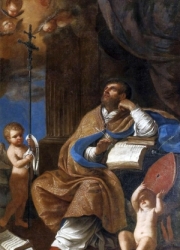
Profile
Adult convert to Christianity. Deacon. Priest. Bishop of Ravenna, Italy in 433. Fought paganism and the Monophysite heresy, enforced reforms, and built several churches and ornate altars in his see. Preacher with such language skills, he was given given the name Chrysologus, referring to his golden word. 176 of his sermons have survived; it is the strength of these beautiful explanations of the Incarnation, the Creed, the place of Mary and John the Baptist in the great plan of salvation, etc., that led to his being proclaimed a Doctor of the Church in 1729 by Pope Benedict XIII.
Born
406 at Imola, Italy
Died
2 December 450 at Imola, Italy
Patronage
• against fever
• against mad dogs
• Imola, Italy
Representation
• bishop being presented to Pope Sixtus III by Saint Peter the Apostle and Saint Apollinaris of Ravenna
• bishop holding a dish
Video
Readings
A gentle maiden having lodged a God in her womb, asks as its price, peace for the world, salvation for those who are lost, and life for the dead. - Saint Peter Chrysologus
Anyone who wishes to frolic with the devil cannot rejoice with Christ. - Saint Peter Chrysologus
We exhort you in every respect, honorable brother, to heed obediently what has been written by the Most Blessed Pope of the City of Rome; for Blessed Peter, who lives and presides in his own see, provides the truth of faith to those who seek it. - Saint Peter Chrysologus, from a letter to Eutyches, 449
I appeal to you by the mercy of God. This appeal is made by Paul, or rather, it is made by God through Paul, because of God's desire to be loved rather than feared, to be a father rather than a Lord. God appeals to us in his mercy to avoid having to punish us in his severity. Listen to the Lord's appeal: In me, I want you to see your own body, your members, your heart, your bones, your blood. You may fear what is divine, but why not love what is human? You may run away from me as the Lord, but why not run to me as your father? Perhaps you are filled with shame for causing my bitter passion. Do not be afraid. This cross inflicts a mortal injury, not on me, but on death. These nails no longer pain me, but only deepen your love for me. I do not cry out because of these wounds, but through them I draw you into my heart. My body was stretched on the cross as a symbol, not of how much I suffered, but of my all-embracing love. I count it no less to shed my blood: it is the price I have paid for your ransom. Come, then, return to me and learn to know me as your father, who repays good for evil, love for injury, and boundless charity for piercing wounds. Listen now to what the Apostle urges us to do. I appeal to you, he says, to present your bodies as a living sacrifice. By this exhortation of his, Paul has raised all men to priestly status. How marvelous is the priesthood of the Christian, for he is both the victim that is offered on his own behalf, and the priest who makes the offering. He does not need to go beyond himself to seek what he is to immolate to God: with himself and in himself he brings the sacrifice he is to offer God for himself. The victim remains and the priest remains, always one and the same. Immolated, the victim still lives: the priest who immolates cannot kill. Truly it is an amazing sacrifice in which a body is offered without being slain and blood is offered without being shed. The Apostle says: I appeal to you by the mercy of God to present your bodies as a living sacrifice. Brethren, this sacrifice follows the pattern of Christ's sacrifice by which he gave his body as a living immolation for the life of the world. He really made his body a living sacrifice, because, though slain, he continues to live. In such a victim death receives its ransom, but the victim remains alive. Death itself suffers the punishment. This is why death for the martyrs is actually a birth, and their end a beginning. Their execution is the door to life, and those who were thought to have been blotted out from the earth shine brilliantly in heaven. Paul says: I appeal to you by the mercy of God to present your bodies as a sacrifice, living and holy. The prophet said the same thing: Sacrifice and offering you did not desire, but you have prepared a body for me. Each of us is called to be both a sacrifice to God and his priest. Do not forfeit what divine authority confers on you. Put on the garment of holiness, gird yourself with the belt of chastity. Let Christ be your helmet, let the cross on your forehead be your unfailing protection. Your breastplate should be the knowledge of God that he himself has given you. Keep burning continually the sweet smelling incense of prayer. Take up the sword of the Spirit. Let your heart be an altar. Then, with full confidence in God, present your body for sacrifice. God desires not death, but faith; God thirsts not for blood, but for self-surrender; God is appeased not by slaughter, but by the offering of your free will. - from a sermon by Saint Peter Chrysologus
https://catholicsaints.info/saint-peter-chrysologus/
Saint María Natividad Venegas de La Torre
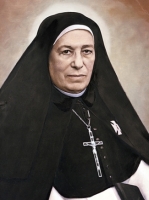
Also known as
• María de Jesús Sacramentado
• María of Jesus in the Blessed Sacrament
• Mary of the Blessed Sacrament Venegas de la Torre
• Nati (childhood nickname)
Profile
Youngest of twelve children in a pious Bible-reading, Rosary-praying family; her father was an accountant and her mother a homemaker. Natividad was early drawn to prayer and contemplation, and made her first Communion at age 9. Her mother died when Nati was 16. The family moved to Compostela, Nayarit, Mexico for financial reasons, and Nati spent even more time in church and in prayer. Her father died when she was 19, and her paternal uncle and aunt took over care of the children who were still at home.
Nati began teaching local children to read, was very active in parish life, became a catechist, and attended daily Mass. She joined the Daughters of Mary on 8 December 1898, and began discerning a call to religious life. Following an Ignatian retreat, she joined the Daughters of the Sacred Heart of Jesus on 8 December 1905; the pious union was dedicated to care of the sick, elderly and abandoned. She worked the next 54 years with the poor and sick in the small Sacred Heart hospital in Guadalajara, Mexico. She served as a nurse, pharmacist, housekeeper, and the community's accountant and the hospital‘s bookeeper. Chosen Superior General of the Daughters in 1921. By 1924 she had written the formal constitutions of the Order, obtained diocean approval, and is considered the founder of the Congregation. She served as leader of the Daughters for 35 years during which they inceased vocations, opened hospitals and clinics, and founded several houses; she took the name María of Jesus in the Blessed Sacrament. Wrote a number of pieces about her region.
Beginning in 1926, President Plutarco Elías Calles began enforcing anti-clerical laws, seizing Church property, shutting down Church institutions including schools, hospitals, orphanages and homes for the elderly. Mass was prohibited, religious education outlawed, and all bishops were exiled from Mexico; this persecution started the Cristero War. Mother Nati managed to keep Sacred Heart hospital open during the repressions; when soldiers arrived to close it down, she overwhelmed them with kindness, and she and her sisters treated both soldiers and Cristeros, so the military held off enforcing the order to shut her down. Mother Nati insisted that the Eucharist not be removed from the hospital, and to prevent the soldiers from committing sacrilege, it was often hidden in bee hives on their property.
Mother Nati continued working with the patients until her last days, even when she had to get around in a wheelchair. Her final, bed-ridden days were spent in prayer for them, her hospital and her sisters.
Born
8 September 1868 in La Tapona, Zapotlanejo, Jalisco, Mexico
Died
30 July 1959 in Guadalajara, Jalisco, Mexico of natural causes
Canonized
• 21 May 2000 by Pope John Paul II
• first canonized Mexican
• canonization celebrated in Saint Peter's Square in Rome, Italy
• her canonization miracle involved the healing of Anastasio Ledezma Mora whose heart stopped during surgery, who went into a coma following resuscitation, and was healed following the prayers by the family for the intercession of Mother Nati
Patronage
• Daughters of the Sacred Heart of Jesus of Guadalajara
• nurses
Readings
She didn't live an extraordinary life. She lived an ordinary life in an extraordinary way. - Sister Clara, who worked with Saint Natividad in her final years
The elderly are travelers who we must take care of before their life ends. We must take care of them with all the tenderness possible. - Saint Natividad
Suffering is short. Our joy will be eternal. - Saint Natividad
Those who are merciful with the needy of the world will not lack God's mercy. - Saint Natividad
The weight of the cross is burdensome for those carrying it, but not for those who embrace it. - Saint Natividad
https://catholicsaints.info/saint-maria-natividad-venegas-de-la-torre/
Saint Leopold Bogdan Mandic
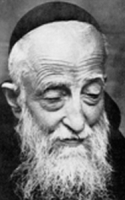
Also known as
• Adeodato Bogdan Mandic
• Apostle of the Confession
• Apostle of Unity
• Bogdan Ivan Mandic
• Brother Leopold
• Leopoldo of Castelnuovo
Profile
Saint Leopold was a contrast between physical frailty and spiritual strength. Four foot five inches tall, and physically weak, his health became worse with age. He had a stammer, suffered abdominal pains, and was gradually deformed by chronic arthritis, making his frame stooped, his hands gnarled, and his life one of endless pain. Spiritually, Leopold Mandic was a giant, full of Christian strength. His humility and faith in God enabled him to accept his poor physical condition, and realize God's power - for without God he could do nothing.
Twelfth child born to Peter and Caroline Mandic. Physically malformed and delicate of health, Bogdan early showed signs of great spiritual strength and integrity. At age 16, Bogdan left Dalmatia for Italy where he became a student at the Capuchin Seraphic School at Udine, and an aspirant to the Capuchins. He applied himself to his studies, and entered the Capuchin Order as a novice on 20 April 1884 at Bassano del Grappa, taking the religious name Brother Leopold. After his Profession of Vows in May 1885, Leopold began clerical studies at Padua and Venice. Ordained in Venice on 20 September 1890.
He wanted to be a missionary in Eastern Europe, an area torn apart by religious strife, but he was denied by his superiors because of his frailty and general ill-health. Stationed at various Friaries in the Venetian Province from 1890 to 1906, including his homeland of Dalmatia, where the Italian friars had a mission. Posted to Padua, Italy in 1906 where, except for a year spent in a prison camp in World War I because he would not renounce his Croat nationality, he remained for the rest of his life. In Padua he became a Confessor and Spiritual Director for almost forty years. Father Leopold encouraged many, especially the hopeless in enslavement to sin. Though he did not go to the missions, his long service in the confessional proved it to be his own apostolate. For nearly forty years, twelve hours a day, he absolved and councelled thousands of penitents, always weak but always available.
Born
12 May 1866 at Herceg Novi, Dubrovacko-Neretvanska Croatia as Adeodato
Died
30 July 1942 at the Friary in Padua, Italy of oesophageal cancer
Canonized
16 October 1983 by Pope John Paul II
Video
Readings
Have faith! Everything will be alright. Faith, Faith! - advice from Saint Leopold Mandic
I am like a bird in a cage, but my heart is beyond the seas. - Saint Leopold Mandic when he realized that he would never be a missionary
We have in heaven the heart of a mother, The Virgin, our Mother, who at the foot of the Cross suffered as much as possible for a human creature, understands our troubles and consoles us. - Saint Leopold Mandic
https://catholicsaints.info/saint-leopold-bogdan-mandic/
Blessed Vicenta Chávez Orozco
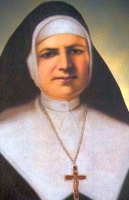
Also known as
María Vicenta of Saint Dorothy
Profile
Youngest of four children, Vicenta was a pious girl, known for her devotion to the Infant Jesus, for making little altars and asking other children to pray with her. She grew up in Mexicaltzingo, a neighborhood inhabited by poor and unskilled workers. Her parish priest, Father Agustin Beas, was devoted to the infirm poor; he set up six beds in a room of his rectory, called it Holy Trinity Hospital, and the sick were cared for by the women of the Saint Vincent de Paul Society. On 20 February 1892 Vicentita entered this hospital with pleurisy, and there received the inspiration to dedicate her life to God in the person of the poor and the sick. By 10 July 1892 she had recovered, and returned to the hospital to begin her life of charity. In 1895 she took private vows. On 12 May 1905 she founded the Congregation of the Servants of the Poor, later renamed the Servants of the Holy Trinity and the Poor. She made her canonical profession in 1911, and was named Superior General in 1913, a service she performed for 30 years, fervent in prayer, seeing obedience as the greatest form of sacrifice.
In 1914, during the Mexican Revolution, Carranza's troops commandeered the cathedral of Guadalajara, and imprisoned priests and religious, including Maria-Vicenta and the Servants. In 1926 Saint Vincent's Hospital in Zapotlan, Mexico was turned into a military headquarters; the Servants ignored the danger, caring for the wounded, and insuring they received reconciliation and Communion. The faith and hard work of the Servants paid off over the years with abundant vocations and 17 new hospitals, clinics and nurseries.
At age 75, Mother Vicentita began to have eye and other health trouble, but was the still first in chapel each morning at 4:00, but on 29 July 1949 did not appear. The chaplain anointed her, and Archbishop Jose Garibi Rivera, the first Cardinal from Mexico, heard her confession and celebrated Mass. At the elevation of the Host, Mother Vicentita dropped into death like a baby falling asleep.
Born
6 February 1867 at Cotija, Michoacan, Mexico as Vicenta Chavez Orozco
Died
30 July 1949 at Holy Trinity Hospital, Guadalajara, Mexico of natural causes
Beatified
9 November 1997 by Pope John Paul II
https://catholicsaints.info/blessed-vicenta-chavez-orozco/
Saint Godelieve
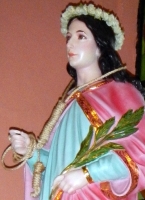
Also known as
• Godelieve of Ghistelles
• Godelieve of Gistel
• Godaleva, Godeleine, Godeleva, Godeliève, Godelina, Godeliva, Godelive, Godelva, Godliva
Profile
Born to the Flemish nobility, the daughter of Hemfried, Lord of Wierre-Effray. Married to Bertulf of Ghistelles, a Flemish nobleman, who abandoned her before the wedding feast was over. Abused by her in-laws, especially her mother-in-law, Godelieve was variously locked in a cell, starved, and subjected to assorted physical and mental abuse. Her father threatened to turn the husband and in-laws over to state and Church authorities; Bertulf appeared to repent, Godelieve returned to him, and was soon after murdered; she is generally considered a martyr. Always a friend of the poor and sick, post-mortem miracles ascribed to her include restoration of sight to her step-daughter.
Born
1049 at Londefort-lez-Boulogne, France
Died
murdered by drowning after being strangled into unconciousness by her mother-in-law's servants on 6 July 1070 at Gistel, Belgium
Patronage
• difficult marriages
• for healthy throats; against throat diseases
• in-law problems
• victims of abuse
• victims of verbal spouse abuse
Representation
• handkerchief
• woman strangled with a handkerchief
• rope
• young woman with a rope around her neck
• young woman with a rope
• young woman with four crowns
https://catholicsaints.info/saint-godelieve/
Blessed Bernard Francis Casey
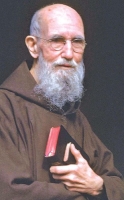
Also known as
• Francis Solanus
• Father Solanus
• Solanus Casey
Profile
Bernard joined the Franciscan Capuchins in 1897. He was ordained a priest in 1904, but because he was unable to complete the academic requirements of priesthood, Father Solanus was limited in his duties, not being permitted to preach, hear Confessions or perform other tasks usually associated with priests, but instead assigned as porter of his house, first in New York and then at the Saint Bonaventure Monastery in Detroit, Michigan. A miracle worker, and a man whose simple faith and deep prayer life led him to be a much sought after spiritual advisor.
Born
25 November 1870 in Oak Grove, Wisconsin
Died
31 July 1957 in Detroit, Michigan of natural causes
Beatified
• 18 November 2017 by Pope Francis
• beatification recognition celebrated at Ford Field, Detroit, Michigan
• his beatification miracle involved the 2012 overnight healing of Paula Medina Zarate of ichthyosis, a genetic condition causes skin to become thickened, scaly and cracked, and for which there is no known cure
Videos
Readings
God will answer our prayers. – the response of Father Solanus to most problems
https://catholicsaints.info/blessed-bernard-francis-casey/
Blessed Manés de Guzmán
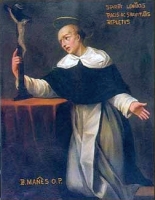
Also known as
Mamerto, Mamés, Manez
Profile
Son of Felix de Guzman and Blessed Juana of Aza; older brother of Saint Dominic de Guzman. Educated by his uncle Gonzalo de Aza in Gumiel de Izan, and he joined the Cistercians in the San Pedro monastery in Gumiel de Izan in 1183. Priest. Helped his brother Dominic found and spread the Dominicans, joining as one of the first 15 members on 15 August 1217. Prior of the Saint-Jacques monastery in Paris, France; founded the sister convent there. Transferred to Madrid, Spain in 1219 to help establish Dominican nuns in that city. He attended the canonization of his brother on 13 July 1234 in Rome, Italy, and returned to Caleruega with plans for a church dedicated to Saint Dominic, but died before it could begin. Known as a quiet and contemplative person, but a fiery and determined preacher, and was invaluable in the early spread of the Dominicans.
Born
c.1170 in Caleruega, Castile (in modern Burgos, Spain)
Died
• 1234 in the monastery of San Pedro de Gumeil, Izan, Castile (in modern Burgos, Spain) of natural causes
• buried at the monastery of San Pedro
Beatified
2 June 1834 by Pope Gregory XVI (cultus confirmation)
Readings
He was a contemplative and holy man. – Fray Gerardo de Frachet
Soft, humble, cheerful and gentle, earnest preacher. – Fray Rodrigo Cerrato
https://catholicsaints.info/blessed-manes-de-guzman/
Blessed Thomas Abel
Also known as
• Thomas Able
• Thomas Abell
Profile
Thomas received his Doctor of Divinity from Oxford University in England. Priest. Chaplain to Queen Catherine of Aragon, wife of King Henry VIII. He delivered the letter of Emperor Charles V that sought the permission and blessing of Pope Julius II for the marriage of Henry and Catherine. He confided to the emperor that Catherine had been coerced into writing the letter; Charles refused to pass on the request to the pope, and Thomas returned empty-handed to England.
When Henry sought to divorce Catherine, Thomas published Invicta Veritas, which argued against Oxford University's support of the divorce; for this he was imprisoned in the Tower of London in 1532. Released soon after, he was arrested again in 1533, accused of involvement in the Holy Maid of Kent incident in which a woman named Elizabeth Barton went into trances at the sight of the image of Mary and gave teachings in favour of the Mass and Catholicism. While in prison, Thomas established a correspondence with Blessed John Forest who was doing time in Newgate prison. The warden of the Tower released Thomas in 1539, but he was soon re-arrested, and the warden was imprisoned for releasing him. Thomas was convicted of high treason on the basis of denying the king's supremacy over the Church. Martyr.
Born
c.1497 in England
Died
hanged, drawn, and quartered on 30 July 1540 at Smithfield, England
Beatified
29 December 1886 by Pope Leo XIII
https://catholicsaints.info/blessed-thomas-abel/
Blessed Sebastià Llorens Telarroja
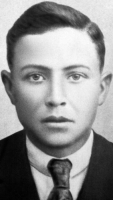
Profile
Studious and pious layman farm worker in the diocese of Girona, Spain, known locally for his mechanical skills. Alumnus of the Colegio Santa María de Blanes in Spain, which was run by the Sons of the Holy Family. Member of Catholic Action. Member of the Federation of Young Christian de Catalunya. Franciscan tertiary known for his charity. Had a dedication to Eucharistic adoration, and devotion to Our Lady of Vilar. As anti–Catholic forces approached, he hid the ancient image of the Virgin of Vilar, patroness of Blanes. Martyred in the Spanish Civil War.
Born
2 December 1909 in Tordera, Barcelona, Spain
Died
• early morning of 30 July 1936 on the highway outside Blanes, Girona, Spain
• buried in the town cemetery of Blanes
Beatified
13 October 2013 by Pope Francis
https://catholicsaints.info/blessed-sebastia-llorens-telarroja/
Blessed Edward Powell
Also known as
Edward Powel
Additional Memorial
1 December as one of the Martyrs of Oxford University
Profile
Educated at Oxford; Fellow of Oriel in 1495. Doctor of Divinity in 1506. Rector of Bleadon, Somerset, England. Priest. Prebendary of Centum Solidorum in Lincoln, England, of Carlton-cum-Thurlby in 1505, of Sutton-in-Marisco in 1525, and of other parishes. Canon of Salisbury. Author of several treatises opposing Martin Luther. Counsellor to Queen Catherine of Aragon, wife of King Henry VIII, and a favourite preacher to the royal court. Convicted on high treason in 1534 on the basis of denying the king's supremacy over the Church. Spent six years imprisoned in the Tower of London before being executed. Martyr.
Born
1478 in Wales
Died
hanged, drawn, and quartered on 30 July 1540 at Smithfield, London, England
Beatified
29 December 1886 by Pope Leo XIII (cultus confirmation)
https://catholicsaints.info/blessed-edward-powell/
Saint Terenzio of Imola
Also known as
Terencio
Profile
Terenzio grew up beside the cathedral in Imola, Italy, and early saw life in the Church as just part of life in general. Deacon. He felt called to move to Faenza, Italy where he lived near the church of Santa Croce, working with the poor and serving at Mass. He one day healed a blind man in from Imola by praying for him. It drew him so much attention and admiration that he fled the city to live as a hermit in the forest outside San Pietro in Laguna, Italy. There he continued a ministry of healing, but insisted on his solitude. Warned of his coming death by an angel, Terenzio spent his final days with his fellow hermits, giving them recommendations for their spiritual lives.
Born
6th to 9th century (records vary) in Imola, Italy
Died
• the forest of San Pietro, Laguna, Italy of natural causes
• relics enshrined in the cathedral of Faenza, Italy
https://catholicsaints.info/saint-terenzio-of-imola/
Saint Abdon and Saint Senen
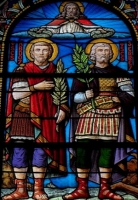
Also known as
Abdo, Abdus
Sennen, Sennes, Senxis, Sennis, Zennen
Profile
A couple of coopers who befriended Christians persecuted under Diocletian. Tortured and executed when they were found collecting the remains of martyrs in order to give them a respectable burial. Martyrs.
Born
Persian
Died
• martyred c.250 at Rome, Italy
• interred in the Benedictine Abbey of Sainte Marie, Arles, France
Patronage
• against eye diseases
• against vermin
• barrel makers, coopers, bucket makers
• blind children
• children
• gardeners
https://catholicsaints.info/saint-abdon/
https://catholicsaints.info/saint-senen/
Blessed Jaume Puig Mirosa
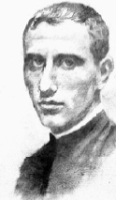
Profile
Priest. Member of the Sons of the Holy Family. Superior of his Order and Director of Colegio Santa María de Blanes in Spain. As anti-Catholic forces approached, he hid the ancient image of the Virgin of Vilar, patroness of Blanes. Martyred in the Spanish Civil War, the first martyr of the Sons.
Born
3 June 1908 in Terrasa, Barcelona, Spain
Died
• early morning of 30 July 1936 on the highway outside Blanes, Girona, Spain
• re-interred in the chapel cemetery of San José Manyanet parish of Barcelona in 2007
Beatified
13 October 2013 by Pope Francis
https://catholicsaints.info/blessed-jaume-puig-mirosa/
Saint Julitta of Caesarea
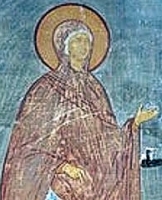
Profile
Rich lay woman in Caesarea, Cappadocia (in modern Turkey) whose property was stolen by an influential local pagan. She took him to court where he objected that she had no standing or rights in court as she was a Christian. The judge ordered her to prove her standing by making a sacrifice to an idol; she refused. She was immediately arrested, convicted of Christianity, and martyred. Saint Basil the Great wrote about her.
Died
• burned at the stake in 303 in Caesarea, Cappadocia (in modern Turkey)
• her body survived intact, and she was given a Christian burial by other faithful
https://catholicsaints.info/saint-julitta-of-caesarea/
Blessed Richard Featherstone
Also known as
Richard Fetherston
Profile
Educated at the University of Cambridge, England. Tutor to Princess Mary Tutor. Archdeacon of Brecknock. Chaplain to Queen Catherine of Aragon, wife of King Henry VIII. He defended Catherine in convocation; charged and found guilty of treason. Martyr.
Born
English
Died
hanged, drawn, and quartered on 30 July 1540 at Smithfield, England
Beatified
29 December 1886 by Pope Leo XIII
https://catholicsaints.info/blessed-richard-featherstone/
Saint Iosephus Yuan Gengyin
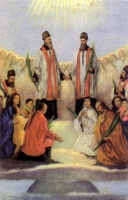
Also known as
Ruose
Profile
Layman merchant in the apostolic vicariate of Southeastern Zhili, China. Seized by followers of the Yihetuan movement and killed for being Christian. Martyr.
Born
c.1853 in Hui, Zaoqiang, Hebei, China
Died
end of July 1900 in Dayin, Zaoqiang, Hebei, China
Canonized
1 October 2000 by Pope John Paul II
https://catholicsaints.info/saint-iosephus-yuan-gengyin/
Blessed Luis Aguirre Bilbao
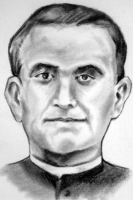
Profile
Orphaned as a small boy. Worked as a mechanic while studying to enter the Vincentians, making his profession on 30 June 1933. Martyred in the Spanish Civil War.
Born
13 September 1914 in Murguía, Vizcaya, Spain
Died
30 July 1936 in Alcorisa, Teruel, Spain
Beatified
13 October 2013 by Pope Francis
https://catholicsaints.info/blessed-luis-aguirre-bilbao/
Saint Hatebrand
Profile
Benedictine monk at Saint Paul's abbey in Utrecht, Netherlands. Abbot of Olden-Klooster, Frisia (in modern Netherlands) in 1183. Revived the Benedictine Rule in Frisia.
Born
Frisia (in modern Netherlands)
Died
1198 of natural causes
https://catholicsaints.info/saint-hatebrand/
Blessed Antonio di San Pietro
Profile
Mercedarian lay brother at the convent of Sant’Anna in Genoa, Italy. Famous within the Order for this chastity, patence, penance and deep prayer life.
Died
1618 of natural causes
https://catholicsaints.info/blessed-antonio-di-san-pietro/
Saint Tatwine of Canterbury
Profile
Monk at Breedon Abbey, Mercia (in modern England). Famed for his piety and learning. Archbishop of Canterbury, England.
Died
734 of natural causes
https://catholicsaints.info/saint-tatwine-of-canterbury/
Saint Ursus of Auxerre
Profile
Hermit who lived at the church of Saint Amator in Auxerre, France. Bishop of Auxerre at age 75.
Died
508
https://catholicsaints.info/saint-ursus-of-auxerre/
Saint Ermengyth
Also known as
Ermengitha, Ermengytha
Profile
Sister of Saint Ermenburgh. Nun at Minster-in-Thanet, Kent, England.
Died
c.680
https://catholicsaints.info/saint-ermengyth/
Martyrs of Castelseras
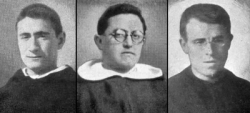
Profile
Three Dominicans, two of them priests, one a novice, who were martyred together in the Spanish Civil War for refusing to renounce Christianity.
• Joaquín Prats Baltueña
• José María Muro-Sanmiguel
• Zosimo Izquierdo Gil
Died
shot on 30 July 1936 at a farm house outside Castelserás, Teruel, Spain
Beatified
11 March 2001 by Pope John Paul II
https://catholicsaints.info/martyrs-of-castelseras/
Martyrs of Tebourba
Profile
Three girls martyred together in the persecutions of Diocletian. We know little else about them but the names – Donatilla, Maxima and Secunda.
Died
304 at Tebourba in North Africa
https://catholicsaints.info/martyrs-of-tebourba/
Martyred in the Spanish Civil War
Thousands of people were murdered in the anti-Catholic persecutions of the Spanish Civil War from 1934 to 1939. I have pages on each of them, but in most cases I have only found very minimal information. They are available on the CatholicSaints.Info site through these links:
• Blessed Alejandro González Blanco
• Blessed Eugenio García Tribaldos
• Blessed Guillermo álvarez Quemada
• Blessed José Frías Ruiz
• Blessed Juan Lanz Palanca
• Blessed Luis Herrero Arnillas
• Blessed Miguel Solas del Val
• Blessed Pablo Díaz de Zárate y Ortiz de Zárate
• Blessed Ricardo Pla Espí
• Blessed Sergio Cid Pazo
• Martyred Hospitallers of Spain
CatholicSaints.Info Portable Edition